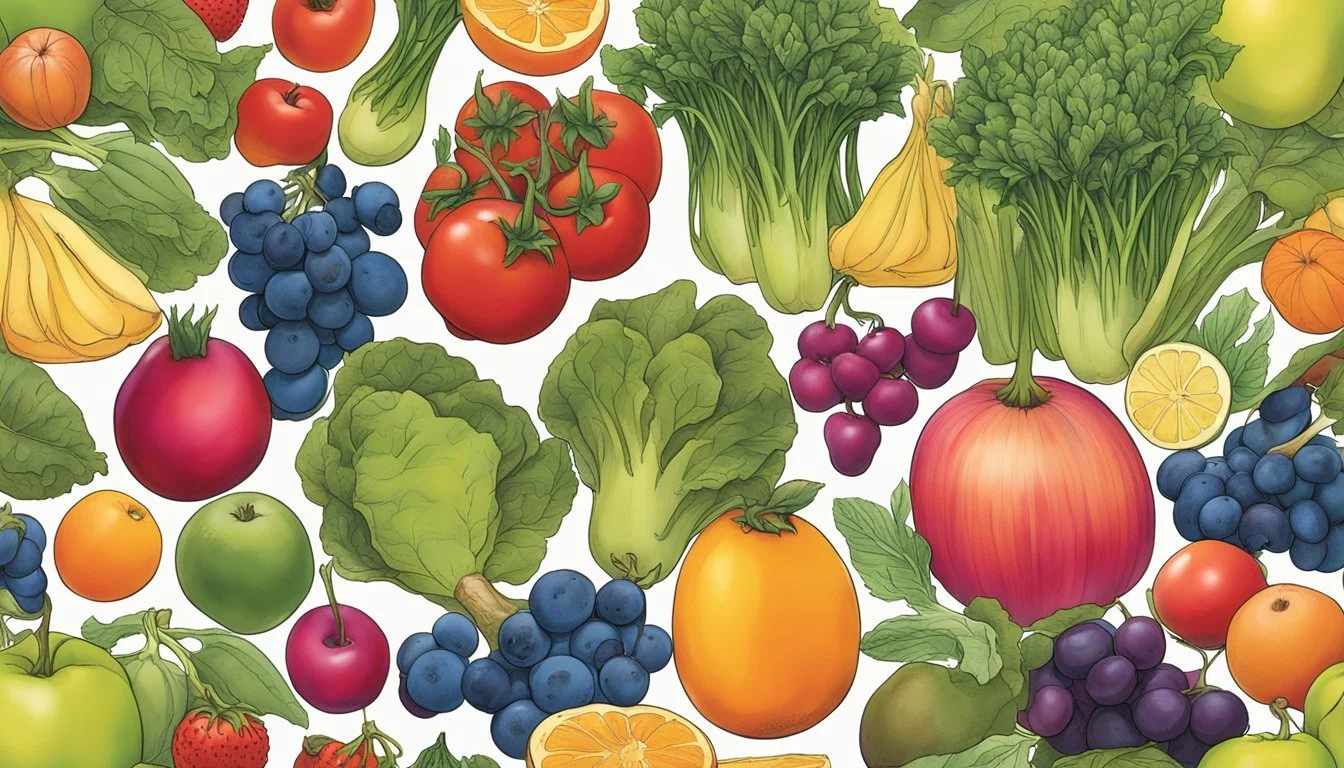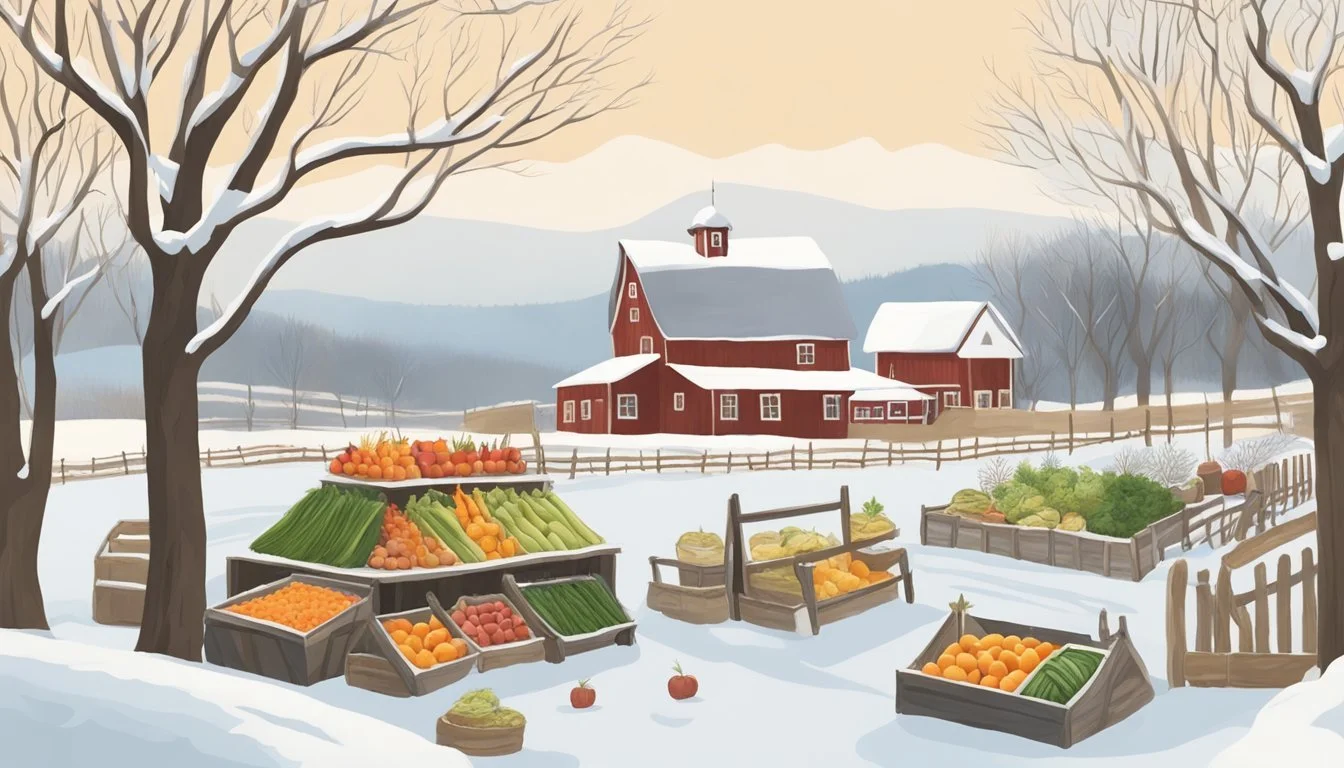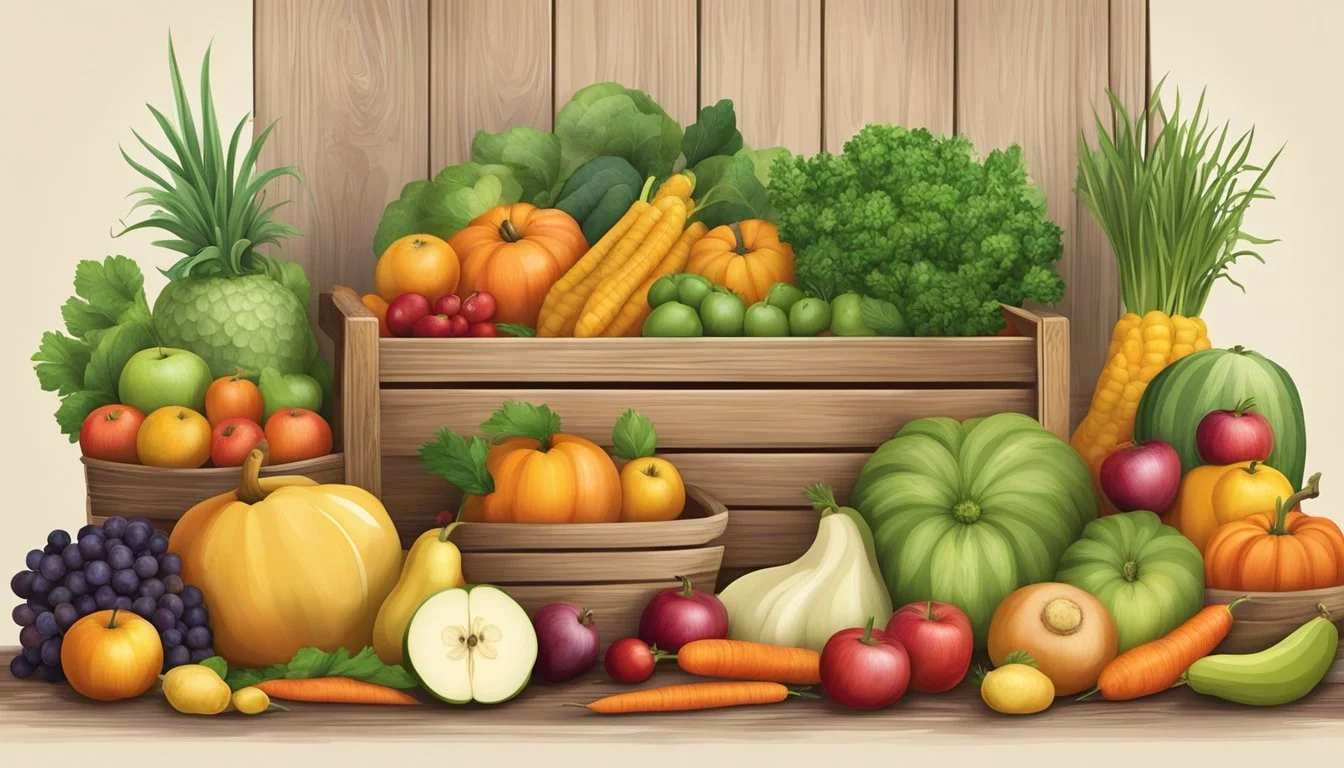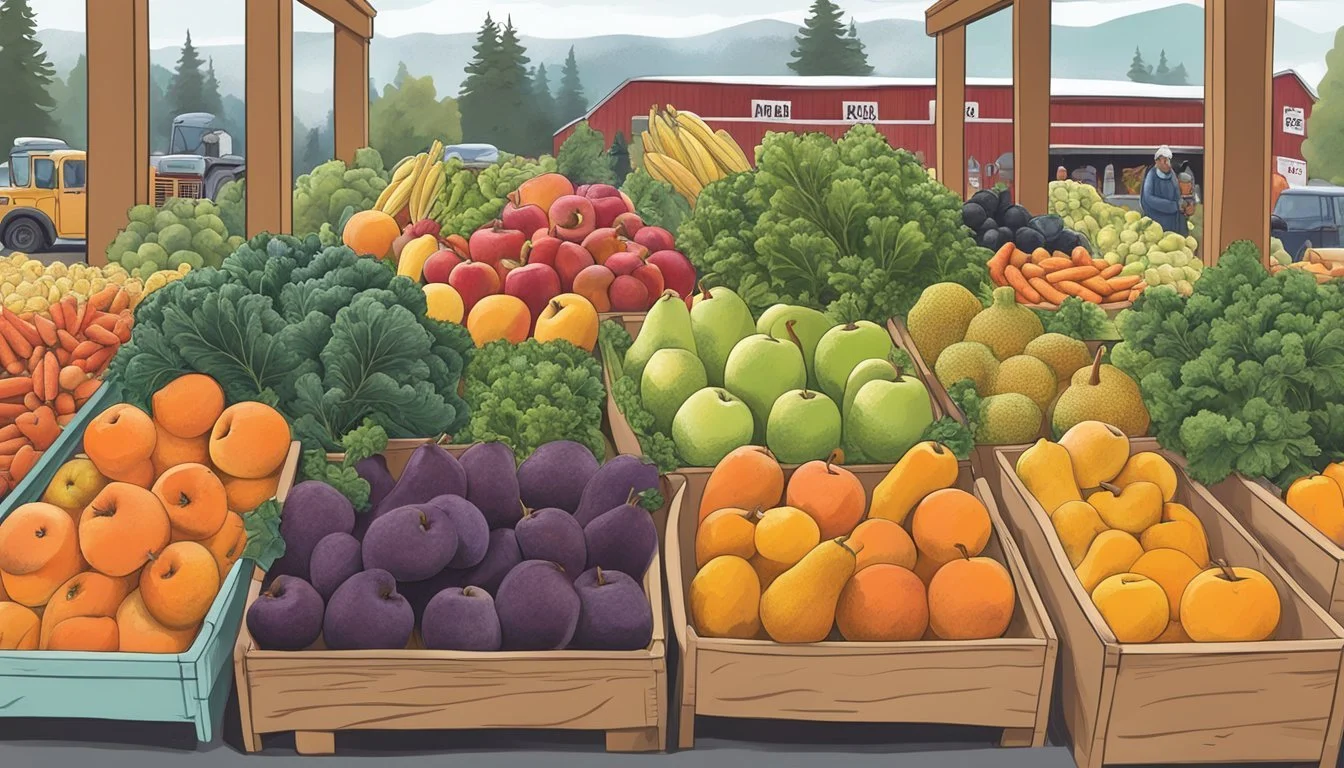Vermont Seasonal Fruit & Vegetables in February
A Guide to Winter Harvest
This Article is Part of our Vermont Seasonal Fruit & Veg Calendar
In Vermont, February is a time when the fields rest under a blanket of snow, but that doesn't mean the availability of fresh produce is entirely dormant. Seasonal eating in this month relies heavily on stored crops and hardy greens that can withstand the cold climate. Root vegetables such as potatoes and carrots (how long do carrots last?), which were harvested in the fall, continue to be staples due to their long shelf-life. Locally grown storage apples (how long do apples last?) and winter squash are also commonly found, providing sweetness and sustenance through the colder days.
Apart from storage crops, Vermont's winter greenhouses offer a supply of fresh, leafy vegetables. Greens like kale and spinach are capable of surviving the region's chilly temperatures, sometimes even growing under the protection of hoop houses and cold frames. This resilience allows them to be included in the list of fresh February offerings. While the selection of in-season produce may be leaner than the summer months, it represents a critical aspect of sustainable local agriculture and supports the economy of Vermont farmers.
The importance of seasonal produce is reflected not just in its environmental benefits, but also in its nutritional value. Eating seasonally ensures that one consumes fruits and vegetables at their peak of flavor and nutritional content. While February in Vermont does not boast the variety seen in the summer months, it offers its own selection of fruits and vegetables that are suited to the regional climate and culinary traditions.
Vermont's Seasonal Produce Overview
February in Vermont is deep within the winter season, and while the fields are resting under a blanket of snow, there are still seasonal produce items available through storage and greenhouse cultivation that provide fresh options for consumers.
Seasonal Fruits
Apples: Stored from the fall harvest, apples remain crisp and are a staple in the winter diet.
Available varieties may include: McIntosh, Empire, and Gala.
Seasonal Vegetables
Root Vegetables: They dominate the seasonal availability list, having been stored effectively post-harvest.
Commonly found types include:
Carrots
Beets (how long do beets last?)
Leafy Greens: These vegetables are often grown in greenhouses to provide fresh greens even in the colder months.
Examples are:
Spinach
Kale
Alliums: The storage-friendly nature of these vegetables makes them available throughout the winter.
Includes:
Onions
Garlic
Cabbages: Hardy and storage-tolerant, cabbages offer a versatile ingredient for winter meals.
Varieties such as:
Potatoes: A staple that stores well and offers a hearty component to many dishes.
Typically found types are:
Russet
Yukon Gold
Squash: Winter varieties are a highlight of the season and can be kept for extended periods.
Popular choices include:
Butternut
Acorn
Delicata
These fruits and vegetables are a testament to Vermont's robust agricultural practices, providing nourishment even in the colder months.
Benefits of Eating Seasonal
When consumers choose to eat seasonal fruits and vegetables, they experience several benefits ranging from improved taste to economic savings. Farms in Vermont, and similar states, typically offer produce that aligns with the natural ripening seasons, ensuring maximum freshness and quality.
Enhanced Flavor
Seasonal produce, harvested at the peak of its ripeness, offers superior flavor and quality. Fruits and vegetables consumed during their appropriate seasons tend to have a more vivid taste and aroma, providing consumers with an enjoyable eating experience. Vermont farms take pride in offering fresh, flavorful produce that reflects the true taste of the season.
Nutritional Value
Eating fruits and vegetables in season not only enhances flavor but often leads to better nutritional value. Seasonal produce is harvested at the perfect time for optimal nutrition. For example, leafy greens grown during the colder months in Vermont have time to develop without the stress of the summer heat, potentially increasing their nutrient density.
Nutrient Retention: Shorter time from farm to table means less nutrient loss.
Diverse Diet: Seasonal eating encourages a varied diet throughout the year.
Economic Advantages
Purchasing seasonal produce also offers economic benefits. Consumers will find that seasonal fruits and vegetables from local Vermont farms are often more affordable due to lower transportation and production costs.
Cost Savings: Seasonal produce grows without the need for extra resources, making it cheaper.
Support Local Economy: Buying from local farms supports state agriculture and community businesses.
Eating seasonally brings individuals closer to the source of their food, supporting state farms, enhancing health, and indulging in the full flavor potential of fresh produce.
February's Harvest Calendar
In February, Vermont's cold climate yields a variety of hearty vegetables and stored fruits from the previous season's harvest.
Fruits Available in February
Within the bounds of Vermont's chilly February climate, fruits are typically those kept in cold storage from the previous year's harvest. The list includes:
Apples: A staple available throughout the winter months.
Pears: Although not as abundant as apples, pears remain available through careful storage.
Vegetables Available in February
The state's harvest of vegetables in February leans heavily on storage crops and those that thrive in cooler temperatures. The selection comprises:
Potatoes: An enduring storage crop found in many Vermont root cellars.
Carrots: Retains their sweetness and crunch even in the cold.
Onions and Garlic: Essential flavoring agents that are available year-round.
Cabbage: A versatile vegetable that is well-suited to the cooler season.
Winter Squash: Stores exceptionally well, offering a sweet and creamy option.
Parsnips: Their flavor is actually enhanced with the cold, becoming sweeter.
Turnips: Robust root vegetables that are a staple in the winter.
Kale: Tough greens that can survive in the garden even through snow.
Brussels Sprouts: Typically harvested into the early winter but often available from storage.
Broccoli: Another cold-hardy vegetable that can extend into winter.
Celery: Stalks preserved in root cellars.
Sweet Potatoes: A sweet and nutritious storage crop.
It must be noted that while citrus fruits like lemons, oranges, and grapefruit are available in the market, they are not local to Vermont and are imported from warmer climates during this season.
Sourcing Local Produce
In Vermont during February, local produce can be sourced directly from farms or through community-supported winter markets. These venues provide residents with access to fresh, seasonal produce, even in the colder months.
Finding Farms
Vermonters can locate nearby farms that offer February-harvested produce by utilizing community-based maps and online directories. Farms like Birdsong Farm are examples of local providers that focus on environmentally sound and socially just practices. They supply a range of vegetables that can withstand the Vermont winter climate. Accessibility to local farms not only supports the local economy but also ensures fresh produce reaches consumers with minimal transportation, thereby preserving its nutritional value and taste.
Visiting Winter Markets
Winter markets in Vermont operate as key points of sale for seasonal fruits and vegetables sourced locally. The Vermont Farmers Market exemplifies such a community hub where various vendors gather to offer their fresh produce. Even in the chill of February, these markets showcase a robust selection of produce, from storage crops like root vegetables to greenhouse-grown greens. The advantage of visiting these markets is that they serve as a one-stop destination for a diverse offering of local foods, further fostering community relationships between consumers and growers.
Month-by-Month Consumption Guide
February in Vermont is characterized by the depth of winter when fresh produce selection is more limited. During this time, root vegetables and stored produce from the fall harvest are commonly consumed. One might find:
Storage apples, still crisp from the autumn picking.
Potatoes and carrots, which are often cellared to last through the winter months.
Preserved goods, such as pickles and canned fruits, from the previous year's abundance.
As the seasons change, the selection broadens:
March begins to hint at spring's arrival, though fresh produce remains similar to February's offerings.
When July rolls around, one luxuriates in the summer harvest with a rich variety of fruits and vegetables like blueberries, cherries, and cucumbers.
In September, the bounty of apples returns alongside the likes of tomatoes and eggplants, highlighting the full swing of fall.
In all seasons, Vermonters value the consumption of what is currently available and most fresh. As months progress into summer and fall, the diversity on the plate increases significantly, moving from hearty storage vegetables to an array of vibrant, freshly picked goods. This guide serves as an invitation to embrace the natural cycle of produce in Vermont, enjoying each season's unique offerings.
Recipes and Preparation
In Vermont during February, residents have a bounty of seasonal produce at their disposal, providing ample opportunities for creative and hearty dishes. Root vegetables and robust greens take center stage in recipes, with chefs and home cooks alike finding innovative ways to bring warmth and nutrition to the winter table.
Salads and Side Dishes
Vermonters often incorporate spinach and leeks in their salads and side dishes to maximize the use of locally available vegetables. A popular salad might feature a mix of fresh spinach leaves, roasted beets, and goat cheese, dressed with a vinaigrette made from local herbs. Side dishes could include caramelized roasted parsnips, enhanced with a touch of Vermont maple syrup, (how long does maple syrup last?) or a savory leek and white bean gratin, seasoned with thyme and rosemary.
Main Courses
For main courses, root vegetables like beets and parsnips serve as hearty foundations for stews and roasts. A traditional Vermont beef stew (What wine goes well with beef stew?) might be enriched with chunks of these root vegetables, simmered until tender. Another favorite is a roasted cauliflower and chickpea curry, infused with local spices, demonstrating the versatility of February produce in main dishes.
Desserts and Beverages
When it comes to desserts and beverages, February's chilly days are an invitation to create warming treats and drinks. Smoothies made with spinach and local apples provide a nutritious boost, while desserts may showcase the natural sweetness of roasted beets in a chocolate-beet cake or beetroot halva. For a comforting drink, one might enjoy a hot herbal tea blend featuring Vermont-grown peppermint or chamomile to sooth and warm during the winter months.
Food Storage Tips
Proper storage extends the life of Vermont's seasonal fruits and vegetables and ensures they retain their freshness and nutritional value. This section offers guidance on preservation techniques and tips for enhancing the shelf life of February's produce.
Preservation Techniques
For most vegetables, such as carrots and broccoli, the best preservation method is blanching followed by freezing. Blanching involves briefly cooking vegetables in boiling water, then plunging them into ice water. This process preserves color, flavor, and nutrients. Once blanched, vegetables should be dried, packed into airtight containers or bags, and frozen.
Fruits like apples can be preserved by caning or dehydrating. Apples should be peeled, cored, and sliced before being packed into jars with a simple syrup or dehydrated until they are leathery but not brittle.
Extending Shelf Life
To extend the shelf life of fresh produce:
Refrigeration: Vegetables like cauliflower and sweet potatoes should be kept in the crisper drawer of the refrigerator to maintain humidity while avoiding moisture buildup.
Counter Storage: Some fruits, such as apples and pears, ripen well on the counter but should be stored away from direct sunlight and heat sources.
Separation: Certain fruits, like apples, emit ethylene gas, which can accelerate the ripening and spoilage of nearby ethylene-sensitive produce like broccoli. Store these separately.
Using these tailored techniques ensures proper storage and longevity for Vermont's seasonal fruits and vegetables.
Health and Nutrition
Consuming fruits and vegetables during their peak season can lead to better health and nutrition. February in Vermont offers specific produce known for its dietary benefits and nutritional value.
Dietary Benefits
The fruits and vegetables available in Vermont during February are packed with vitamins, minerals, and fiber, essential for maintaining a balanced diet. For example, root vegetables like beets and carrots are high in fiber and antioxidants, while cabbage and parsnips offer vitamins C and K. Here is a brief overview of the nutritional content of some February produce:
Apples: High in fiber and vitamin C; may aid in digestion and immune support.
Beets: Rich in folate and manganese; supports brain health and energy levels.
Cabbage: Excellent source of vitamin K and vitamin C; beneficial for bone health and immune function.
Carrots: Loaded with beta-carotene which converts to vitamin A; essential for eye health.
Garlic: Contains allicin; known for its anti-inflammatory and cholesterol-lowering properties.
Including these items in one's diet can boost nutrient intake and support overall well-being.
Seasonal Eating Patterns
Adopting seasonal eating patterns has its advantages. Individuals can enjoy produce at its peak freshness and nutritional content, which can enhance flavor and appeal, potentially leading to increased consumption of fruits and vegetables. In February, consumers can look for:
Root vegetables: Known for their ability to store well, offering a robust supply of essential nutrients during the winter months.
Leafy greens: Such as spinach and kale, which are often available from winter greenhouses, providing vitamins A, C, and K.
Buying seasonal produce not only supports one's health and nutrition but also local Vermont farmers and the local economy, promoting sustainability and community health.
Community Impact
Vermont's commitment to seasonal fruit and vegetable consumption in February has positive ramifications for both local agriculture and the broader economy. This approach bolsters community ties and sustains the state's agricultural heritage.
Supporting Local Agriculture
February in Vermont presents opportunities for consumers to support local farmers by purchasing storage crops and value-added products. This support helps maintain the viability of farms during the colder months, when field crops are sparse. The economic benefits for local farmers are tangible, as direct sales in winter can provide essential income to sustain their operations year-round.
Stored Vegetables: Potatoes, carrots, onions, beets, and other root vegetables
Value-Added Products: Jams, preserves, and pickled goods from previous harvests
Seasonal Eating and Economy
The state's economy benefits from the community's commitment to seasonal eating. By purchasing local produce, consumers are directly investing in the state's agricultural sector, which in turn stimulates job creation and the growth of related industries. Vermont food programs often collaborate to support the cycle of local consumption, providing educational materials and emphasizing the health and economic advantages of seasonal eating.
Economic Stimulus: Increased demand for local produce encourages a thriving agricultural market.
Educational Outreach: Initiatives such as Vermont Harvest of the Month educate on the benefits of seasonal consumption.
Challenges and Considerations
In February, Vermont farmers and consumers face unique challenges related to fruit and vegetable distribution. This section explores the complexity of these challenges, specifically focusing on availability issues, price fluctuations, and weather dependency.
Availability Issues
In Vermont, February is not the peak season for a wide variety of fruits and vegetables, leading to limited availability of fresh, local produce. Storage crops like potatoes, carrots, and beets may still be supplied from the fall harvest, but many others are not accessible fresh. Consumers seeking local produce need to rely on storage options or greenhouse-grown items.
Price Fluctuations
Due to off-season scarcity and the increased cost of greenhouse growing or cold storage, prices for fresh produce can rise significantly during the winter months. The consumer's desire for fresh fruits and vegetables has to balance with the willingness to pay higher prices for items like garlic, onions, and apples that are not in their natural growing season.
Weather Dependency
Weather plays a critical role in the production and distribution of fruits and vegetables. February's cold and potentially harsh conditions can impede transportation and lead to crop loss in greenhouses without adequate protection. Even cold-tolerant crops can suffer if the weather is unexpectedly severe, impacting both availability and price.
Conclusion
In February, Vermont’s fields and orchards are typically at rest; however, this does not mean that local produce is unavailable. Root vegetables like beets, carrots, and potatoes maintain their prominence in the markets, offering nourishment with their earthy flavors. Cabbage and onions also persist through the colder months, thanks to their hardy nature and storage feasibility.
The Vermont produce calendar reveals a narrowed, yet valuable selection of fruits and vegetables that endure the winter. While not the peak of abundance, this month still provides opportunities for seasonal cooking. Storage crops such as apples from the previous harvest remain in good condition and continue to be a staple in many households.
Residents and chefs alike take pride in utilizing what is available, showcasing Vermont's resilience and culinary adaptability. The practice of consuming seasonal produce even in the depths of winter reflects a commitment to sustainability and local agriculture.
It is clear that despite the chill of February, Vermont's offerings from its farms are anything but barren. These crops are treasured for their ability to withstand the cold and provide fresh, local produce to the community during a time when imported goods are more common.












